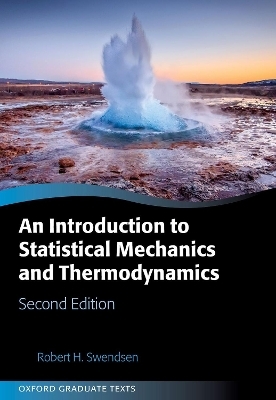
An Introduction to Statistical Mechanics and Thermodynamics
Oxford University Press (Verlag)
978-0-19-885323-7 (ISBN)
An Introduction to Statistical Mechanics and Thermodynamics returns with a second edition which includes new chapters, further explorations, and updated information into the study of statistical mechanics and thermal dynamics.
The first part of the book derives the entropy of the classical ideal gas, using only classical statistical mechanics and an analysis of multiple systems first suggested by Boltzmann. The properties of the entropy are then expressed as "postulates" of thermodynamics in the second part of the book. From these postulates, the formal structure of thermodynamics is developed.
The third part of the book introduces the canonical and grand canonical ensembles, which are shown to facilitate calculations for many model systems. An explanation of irreversible phenomena that is consistent with time-reversal invariance in a closed system is presented.
The fourth part of the book is devoted to quantum statistical mechanics, including black-body radiation, the harmonic solid, Bose-Einstein and Fermi-Dirac statistics, and an introduction to band theory, including metals, insulators, and semiconductors. The final chapter gives a brief introduction to the theory of phase transitions.
Throughout the book, there is a strong emphasis on computational methods to make abstract concepts more concrete.
Robert Swendsen received his BS from Yale and his PhD from the University of Pennsylvania. He did postdoctoral work at the Universität zu Köln, Germany, the Kernforschungsanlage in Jülich, Germany, and Brookhaven National Laboratory. From 1978 to 1984 he worked at the IBM Zurich Research Center. In 1984, he joined Carnegie Mellon University. He is a Fellow of both the American Physical Society and the American Association for the Advancement of Science. He was given an IBM Outstanding Achievement Award in 1981 and shared a Forefronts of Large-Scale Computational Problems Award with S. Kumar, J.M. Rosenberg, and P.A. Kollman in 1991. He was awarded the 2014 Aneesur Rahman Prize for Computational Physics and the 2014 Julius Ashkin Teaching Award in the Mellon College of Science at Carnegie Mellon University.
Preface
Introduction1:
Part 1 Entropy
2: The Classical Ideal Gas
3: Discrete Probability Theory
4: The Classical Ideal Gas: Configurational Entropy
5: Continuous Random Numbers
6: The Classical Ideal Gas: Energy-Dependence of Entropy
7: Classical Gasses: Ideal and Otherwise
8: Temperature Pressure, Chemical Potential, and All That
Part 2 Thermodynamics
9: The Postulates and Laws of Thermodynamics
10: Perturbations of Thermodynamic State Functions
11: Thermodynamics Processes
12: Thermodynamic Potentials
13: The Consequences of Extensivity
14: Thermodynamic Identities
15: Extremum Principles
16: Stability Conditions
17: Phase Transitions
18: The Nernst Postulate: the Third Law of Thermodynamics
Part 3 Classical Statistical Mechanics
19: Ensembles in Classical Statistical Mechanics
20: Classical Ensembles: Grand and Otherwise
21: Refining the Definition of Entropy
22: Irreversibility
Part 4 Quantum Statistical Mechanics
23: Quantum Ensembles
24: Quantum Canonical Ensemble
25: Black-Body Radiation
26: The Harmonic Solid
27: Ideal Quantum Gases
28: Bose-Einstein Statistics
29: Fermi-Dirac Statistics
30: Insulators and Semiconductors
31: Phase Transitions and the Ising Model
Appendix
Appendix: Computer Calculations and VPython
Index
Index
Free
| Erscheinungsdatum | 14.02.2020 |
|---|---|
| Reihe/Serie | Oxford Graduate Texts |
| Zusatzinfo | 28 b/w line illustrations |
| Verlagsort | Oxford |
| Sprache | englisch |
| Maße | 175 x 252 mm |
| Gewicht | 1104 g |
| Themenwelt | Naturwissenschaften ► Physik / Astronomie ► Angewandte Physik |
| Naturwissenschaften ► Physik / Astronomie ► Thermodynamik | |
| ISBN-10 | 0-19-885323-8 / 0198853238 |
| ISBN-13 | 978-0-19-885323-7 / 9780198853237 |
| Zustand | Neuware |
| Haben Sie eine Frage zum Produkt? |
aus dem Bereich


